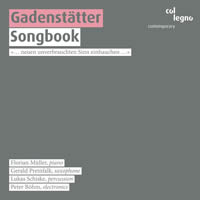Eastern Kingdom 1, Federal Republic 0
|
Dan Albertson [December 2008.]
Clemens GADENSTÄTTER: Songbook #0–11 (2001–02); akkor(d/t)anz (1999–2000). Gerald Preinfalk (amplified saxophones); Florian Ernst Müller (amplified piano); Lukas Schiske (amplified percussion); Peter Böhm (live electronics). col legno WWE 1CD 20256 (http://www.col-legno.com/). Distributed in the US by Allegro Music (http://www.allegro-music.com/). Austrian composer Clemens Gadenstätter (born 1966), as his age might suggest, comes from the generation of composers awash with second-rate Grisey and Lachenmann clones. He too studied with Lachenmann in Stuttgart, and while this disc proves that he has inherited his teacher’s ear for sonority, Gadenstätter’s music is much less rigorous in its application of extended techniques. Indeed, other parameters come to the fore here, rhythm in the first work and harmony in the second. Songbook #0–11 is written for saxophone-piano-percussion trio, a combination that has enjoyed some popularity in the past decade, owing above all to the existence of the German group Trio Accanto, though a fine trio of other musicians drawn from Klangforum Wien perform here. Gadenstätter’s piece is unapologetic about its rock-music origins. However, the work eschews imitation, and though its energy level is quite high at the onset, by midpoint, contemplation replaces frenzy. The saxophone motifs in one movement in particular, 7, reminded me of a foghorn! I am not convinced by each of the 12 sections, but the overall ride is more enjoyable than tedious. One of the few drawbacks is the overuse of live-electronic “special effects,” intended no doubt to enchance the music by way of distortion, yet adding little to the cumulative experience. The other work is for pianist Florian Ernst Müller alone, and it too alternates between stasis and bustle, with a preponderance of the former. The music is a catalogue of sorts but remains undogmatic. Solo piano music is not my forte and the piece tires after a while, a judgment only momentarily obscured by a jubilant dance near the two-thirds mark of its almost 40-minute duration.
Reinhard SCHWARZ-SCHILLING: Introduction and Fugue (1948 or 1949, the booklet is ambiguous); Symphony in C (1963); Sinfonia diatonica (1957). Staatskapelle Weimar, José Serebrier (cond.). Naxos 8.570435 (http://www.naxos.com/). Herr Schwarz-Schilling (1904–85), despite a long career in Berlin, was unknown to me before this disc. As much as I would have preferred hearing him as the musical equal of his contemporary Karl Amadeus Hartmann, I fear that his obscurity may be justified. Brass and strings dominate both symphonies’ bland orchestration. Winds, notable for their presence if not for the quality of their cantilenas, make rare solo appearances. He also has an unfortunate habit, perhaps derived from Hindemith, of interrupting melodic lines with accents, often of unpitched percussion, flourishes which serve no purpose and which are surprising for a “classicist.” The innocuous music, far too passive for this listener, has not been aided by what I hear as tentative and at times timid performances.
[More Dan Albertson]
[More
Gadenstätter, Schwarz-Schilling]
[Previous Article:
Beethoven’s Diabelli Variations, Op. 120, Part 1.]
[Next Article:
Golden Oldies: EMI's Icon Series -- The Singers]
|

